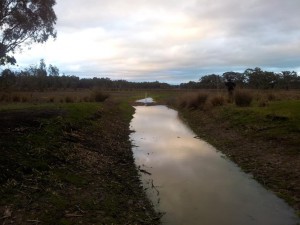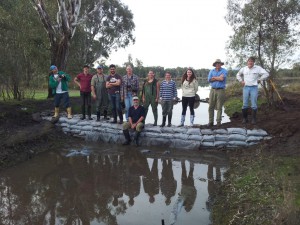The Gooseneck Swamp restoration trial is underway!
A lot has happened since the last update on Gooseneck Swamp….!
As well as some further review of previous studies and a closer look at the new detailed Digital Elevation Model (DEM) data for the site (work funded earlier in the year by the Glenelg Hopkins CMA), rapid progress with project communication and planning tasks meant that the restoration trial was ready to go ahead of schedule. Note: for more background information, please visit the Gooseneck Swamp Restoration Trial Project Page.
With this in mind, Dan and I headed out on site a few weeks ago to assess conditions on the ground and found that (although the drains upstream had commenced flowing and the connecting drain held a puddle of water) Gooseneck Swamp itself remained dry. So rather than wait another whole year before the trial would commence, the decision was made to plan for the works to occur immediately, in the hope that the swamp would receive sufficient flows this year to begin the restoration trial.
The subsequent couple of weeks were pretty wet (better late than never!) – meaning that by the time we arrived on site to undertake the works on Monday the 26th August, there was a little more water around than on our last visit! The swamp had gone from being empty to now holding enough water for the artificial drain to have commenced discharging a steady flow.
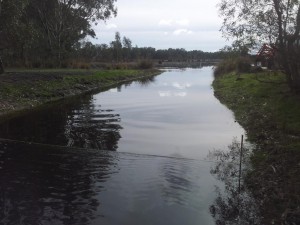
Site conditions upon arrival at the site on the 26th August looking towards Gooseneck Swamp from the drain. The pegs indicate the proposed location of the sandbag weir, and the string-line was used to monitor the downstream change in channel water level in response to the works throughout the day,
Before we started any works, I also checked the the natural outlet at the western end of the lunette (a short distance away) and discovered it was completely dry – clearly demonstrating the impact that the artificial cutting is having in removing water from Gooseneck Swamp at elevations below its natural sill level.
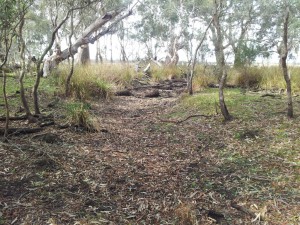
Dry on the 26th August – The natural flowpath between Gooseneck Swamp and Brady Swamp, to the west of the artificial cutting in the lunette that separates the two wetlands.
With the change in conditions, some improvisation was required to sufficiently reduce the drain flow rate – to make working on the sandbag weir more feasible. So the first task for the eager “sandbag crew” of 13 volunteers from NGT, the Hamilton Field Naturalists Club, Deakin University and local landholders (plus Doug’s tractor!), was to install an “ultra-temporary” hessian bag and log bund upstream of the selected sandbag weir site.
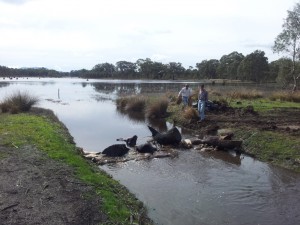
The First Step – Constructing a hessian sandbag and log bund to reduce flow rate and (to a lesser extent) depth in the channel.
Although the wet conditions posed some logistical challenges, once the footing bags of the sandbag structure were firmly in place, the process of building the trial sandbag structure moved along at an excellent pace.
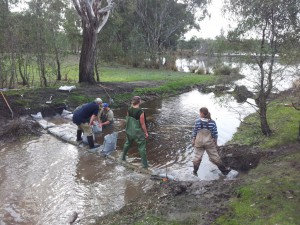
The sandbag crew succeeding in getting the weir to reach the height of the channel water level. Notice the minor drop in water level downstream as the weir under construction starts to hold back water.
Once the structure was above water level, the job of laying sandbags was made somewhat easier and the structure was completed in quick time, having a noticeable and immediate impact on water levels.
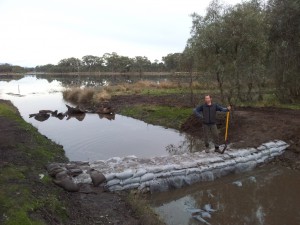
Lachlan standing on the completed sandbag weir structure, with the (now inundated) temporary bund visible in the background – no longer having an effect on flows or water level.
We have now achieved a temporary weir height that we are hopeful will get close to lifting levels sufficiently to reactivate the original flow-path – this is something we will keep an eye on over the coming weeks and that may or may not end up happening, subject to rainfall. Either way, this coming spring will be the first in a long time that Gooseneck Swamp will not freely drain once inflows cease – a great outcome for wetland flora and fauna at the site made possible by this trial.
On behalf of NGT, a huge thank you to everyone involved – both on the day, and over the many years have led to this point of getting the trial underway. A particular special mention is deserved for Gavin Cerini, whose dedication to the concept of restoring Gooseneck Swamp dates back to the 1980s, when he was also involved in the site being purchased for addition to the Grampians National Park.


